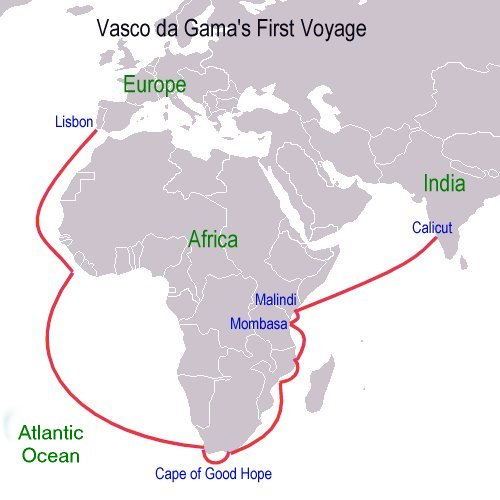

He accomplished what many explorers before him could not do. Vasco De Gama was the first European to find an ocean trading route to India. In an epic voyage, he sailed around Africa's Cape of Good Hope and succeeded in breaking the monopoly of Arab and Venetian spice traders.Ĭorrespondingly, what did Vasco da Gama accomplish? Vasco da Gama was the first European to open a sea-based trade route to India. He also studies navigation and astronomy, and he was friends with Ponce de Leon, who discovered Florida.Vasco da Gama. Much of da Gama’s early life was spent on fishing boats. His second born son later became the governor of Portuguese India.ģ0.

There is a crater on the Moon that was named Vasco da Gama.Ģ9. It was delayed for so many years that da Gama ended up being given the expedition.Ģ8. His father was supposed to be the commander of the expedition to India. However, he died of malaria before he could take over his new post.Ģ7. In 1524, da Gama was named the Governor of India. During this year, he also became the first non-royal blood count in Portugal.Ģ6. Da Gama was given Vidigueira, a newly created county in 1519. While in Calicut, he demanded that all Muslims be banned from India. The ship was set on fire and all those on board died.Ģ4.

On da Gama’s second voyage, he ordered his crew to seize the cargo of an Arab ship carrying as many as 400 passengers. On his second trip, he had 20 armed ships instead of only the four on the original journey.Ģ3. He was the commander of two more trips to India.Ģ2. On the return voyage, half of da Gama’s crew died of scurvy.Ģ1. The spices in India were popular with Europeans, which was one of the reasons the safe passage was necessary.Ģ0. Da Gama took three interpreters on the first voyage.ġ9. Because there was a monsoon wind, they reached India in less than one month.ġ8. The fourth ship didn’t have a name as it was only used for storage.ġ7. His ships were named the San Gabriel, the Sao Rafael, and the Berrio. Da Gama left Portugal on July 8, 1497, to find a sea route to India. Thousands of sailors lost their lives in attacks and shipwrecks while trying to reach India for years before Vasco da Gama made the successful voyage.ġ5. Da Gama’s father was a knight and also an explorer.ġ4. He was born in Sines, a coastal town in Portugal. Historians can’t agree whether he was born in 1460 or 1469, but they do know that he died on December 23rd, 1524.ġ2. In March 2016, thousands of artifacts and nautical remains were recovered from the wreck of the ship Esmeralda, one of da Gama’s armada, found off the coast of Oman.ġ1. His first trip to India is widely considered a milestone in world history, as it marked the beginning of a sea-based phase of global multiculturalism.ġ0. The Portuguese national epic poem, Os Lusiadas, was written in his honor by Camoes.ĩ. Numerous homages have been made worldwide to celebrate his explorations and accomplishments.Ĩ. Da Gama remains a leading figure in the history of exploration.ħ. For his contributions, in 1524, da Gama was appointed Governor of India, with the title of Viceroy, and was ennobled as Count of Vidigueira in 1519.Ħ. The latter was the largest and departed for India four years after his return from the first one.ĥ. Da Gama led two of the Portuguese India Armadas, the first and the fourth. After decades of sailors trying to reach the Indies, with thousands of lives and dozes of vessels lost in shipwrecks and attacks, da Gama landed in Calicut on May 20, 1498.Ĥ. Traveling the ocean route allowed the Portuguese to avoid sailing across the highly disputed Mediterranean and traversing the dangerous Arabian Peninsula.ģ. Da Gama’s discovery of the sea route to India was significant and opened the way for an age of global imperialism and for the Portuguese to establish a long-lasting colonial empire in Asia.Ģ. Take a look below for 30 more fascinating and interesting facts about Vasco de Gama.ġ.

His initial voyage to India was the first to link Europe and Asia by an ocean route, connecting the Atlantic and the Indian oceans and therefore, the West and the Orient. Vasco da Gama, 1st Count of Vidigueira, was a Portuguese explorer and the first European to reach India by sea.


 0 kommentar(er)
0 kommentar(er)
